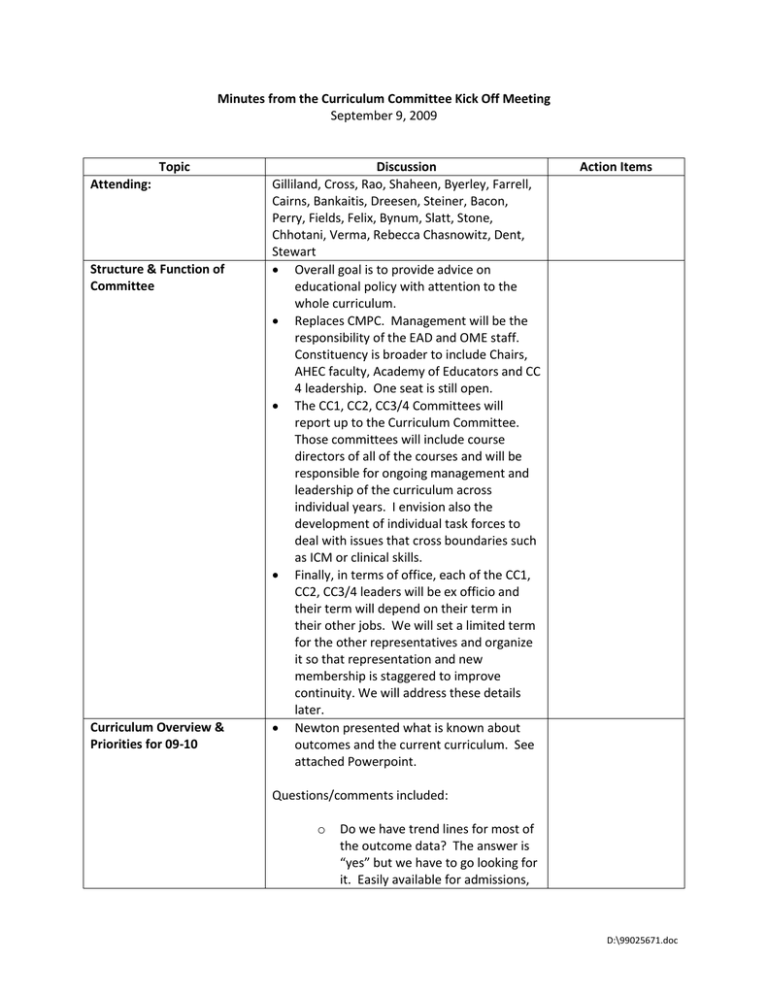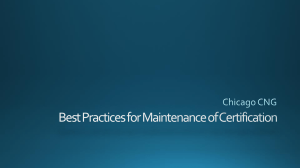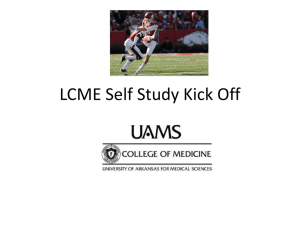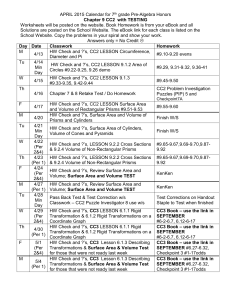Minutes from the Curriculum Committee Kick Off Meeting Topic Discussion Action Items
advertisement

Minutes from the Curriculum Committee Kick Off Meeting September 9, 2009 Topic Attending: Structure & Function of Committee Curriculum Overview & Priorities for 09-10 Discussion Gilliland, Cross, Rao, Shaheen, Byerley, Farrell, Cairns, Bankaitis, Dreesen, Steiner, Bacon, Perry, Fields, Felix, Bynum, Slatt, Stone, Chhotani, Verma, Rebecca Chasnowitz, Dent, Stewart Overall goal is to provide advice on educational policy with attention to the whole curriculum. Replaces CMPC. Management will be the responsibility of the EAD and OME staff. Constituency is broader to include Chairs, AHEC faculty, Academy of Educators and CC 4 leadership. One seat is still open. The CC1, CC2, CC3/4 Committees will report up to the Curriculum Committee. Those committees will include course directors of all of the courses and will be responsible for ongoing management and leadership of the curriculum across individual years. I envision also the development of individual task forces to deal with issues that cross boundaries such as ICM or clinical skills. Finally, in terms of office, each of the CC1, CC2, CC3/4 leaders will be ex officio and their term will depend on their term in their other jobs. We will set a limited term for the other representatives and organize it so that representation and new membership is staggered to improve continuity. We will address these details later. Newton presented what is known about outcomes and the current curriculum. See attached Powerpoint. Action Items Questions/comments included: o Do we have trend lines for most of the outcome data? The answer is “yes” but we have to go looking for it. Easily available for admissions, D:\99025671.doc CC1, CC2, CC3/4 Priorities grades and scores. o What do we know about retention in NC? There is likely good data that we need to develop. We have it in part. This is one of the great advantages of the possibility of working with Sheps more closely. o How much debt does our average student have? $100,000 which is a lot but puts us in the bottom quartile of medical schools. o What information do we have about specialty choice? There is some information but it’s not organized in a helpful way – it is global specialties rather than subspecialties. Our major goal for the next year is to begin to frame according to categories that the NC Institute of Medicine put together. o Any recent changes in MCAT scores? Scores have gone up some in the last year. Roughly 7 points is a significant difference. After changes in administration, there was a major increase approximately 8-9 years ago. Represented orally. See their written descriptions in the agenda. Comments: LCME Action Plan How will we achieve comparability across sites? One45 has begun to allow us to get data across sites and the clinical log will begin to track experience. Lecture capture will improve this as well but we need to review the data on an ongoing basis. CC3/4 will be doing that with this committee involved as necessary. The spread of EHRs will be a significant confounding effect on education. They distract practices on both academic and clinical. The 2004 site visit yielded a follow-up site visit in two years, putting UNC in the bottom 16% in the country. This spring, an D:\99025671.doc internal site review was done by Cam Enarson, former Chair of the LCME who has the achievement of having a perfect LCME score when he was the head of medical education at Wake Forest. The number of possible citations identified by the task force was substantial – the average number of citations in a final report was something like 6-10. Some of the citations are relatively trivial but there are many substantial areas and they fall into three buckets: o Facilities and resources. o Administrative issues such as appointments for faculty, Mission statement reword. o Curriculum – both overall supervision as well as the development of specific competencies. OME has engaged Lisa Slatt to coordinate LCME process. Key points: o o o o Important to get LCME’s 2004 letter. Some of those were included in the packet but we’ll send others out. What’s happened with mistreatment? After many interventions, our statistics have improved to just above the national average. This is quite positive. Alan Cross reported that so far five students have raised issues with him this year. It’s mostly processing and what the students should do. So, it has not gone away but is clearly better. The graduation questionnaire is key and confirms some of what has been said around direct observation of patient examinations as well as some mistreatment. We will review later as a group. A key issue is getting to Slatt and staff will be producing a spreadsheet of each of these items—who is responsible and what’s the next step—for the committee to be aware. Likewise, we’ll follow-up regarding LCME 2004 and subsequent discussions as well as our most recent communication to LCME. D:\99025671.doc Focused Discussion #2 – Faculty Development competencies. What would be the process for doing that. That has to start with this Curriculum Committee setting them for the school and then breaking it down year by year. At that stage, we could involve Course Directors and then some mapping structure needs to be put in to facilitate the process but after we’ve decided what to do. See Newton’s brief proposal. Alan Cross and Kathleen Rao, speaking on behalf of the Academy of Educators, enthusiastically endorsed the proposal. They underscored that the activities would be developed by the Academy of Educators but would be available to all faculty. Other points in the discussion included: The Teaching Scholars has been very helpful both in terms of content and in terms of networking. They will continue. It’s important to develop a number of different modalities based on time available to faculty. So, individual face to face seminars, the Teaching Scholars but also possible web based and other kinds of educational interventions. Faculty development and competencies in learning objectives fit into such an Academy well. It will be important to start going quickly while we’re trying to construct the overall plan. This is something we can design while we’re building. A key faculty need is precepting skills. Needs both resources as well as preceptors. It’s important to put teaching development in the context of overall career faculty development. Current efforts in the School of Medicine are piecemeal, and quite variable from department to department. Some D:\99025671.doc Specific Topic Discussion #3: Hours of the Curriculum departments do better jobs of career development than others. The context is that the SOM faculty development program has been almost exclusively focused on the research side. Educational development needs to get more organized. What’s the role of Chairs in faculty development? Dr. Bankaitis described his approach – find talented people and try to support them moving forward. A key issue is state support for education. Underscore that only a minority of the funds available are for education. We need to get accountability for state funds. Of note, AHEC is very similar to on campuses. Very little of their money comes from the state. Data comparing UNC to benchmark was Consensus: presented. Key questions were: Should we change? If so, what’s the best process? There 1. We have too was consensus that we were likely to be too many hours, and high in terms of hours and that we would need too many in to cut back. However, it’s difficult to know how lecture in years 1 to do this until we’ve sorted out what our and 2. outcomes are. 2. We will defer addressing them It’s important to have some element of a “top until we sort out down” approach. CC3/4 adjustments showed outcomes. that it was very difficult for departments to give up time. Other comments: The gateway exam, if and when it happens, will change the format. What do we know about likelihood? Consensus that we need to do this but after we sort out what our outcomes are. Try to make process independent of funds. This is an advantage of the process we’ve used so far. We need to have some zero based budgeting approach for curriculum hours – where we put in, we have to D:\99025671.doc Outcomes Project Organizing for the Work of the Committee take some out. When we are at our best, what are we doing? Please see Appendix A for a listing of this. What should the core key outcomes of our medical school be – on graduation and in 10-15 years? Please see Appendix B. There was consensus on a hybrid model the Curriculum Committee meeting 2 hours every 2 months and task forces meeting in between. Separately, the CC1, CC2, CC3/4 leaders can meet as an “educational operations” group monthly. D:\99025671.doc



